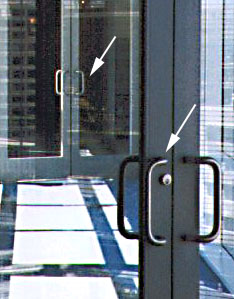Affordance
Designing of things should be done such that it is clear what it is for. A button is for pressing and a knob for turning.
 What about this door here? Handles like this are designed for pulling. There is nothing unintuitive here for the door in the front. You can pull open the door and proceed down to the next door. You pull that door and what happens? The door cannot be opened! It turns out that the back door must be pushed, even though it looks similar to the one in front. In fact, many people got trapped in the walkway as a result.
What about this door here? Handles like this are designed for pulling. There is nothing unintuitive here for the door in the front. You can pull open the door and proceed down to the next door. You pull that door and what happens? The door cannot be opened! It turns out that the back door must be pushed, even though it looks similar to the one in front. In fact, many people got trapped in the walkway as a result.What can be done to remedy this situation? It should be obvious both doors should be pulled. Alternately, a 'Pull' or 'Push' label can be displayed on the door, which i believe to be rather commonplace nowadays.
Consistency
This does not refer to just the colour schemes, but can also refer to placement of buttons and so on. This is one product that is inconsistent.
Feedback
Feedback is incredibly important. We need to know the state of the system. We need to know the impact of what we have done. Is the application processed? Did the system received my application? The following is an example with bad feedback.
And these are just 3 simple examples of bad designs. These examples are taken from http://www.baddesigns.com/, which has many more of them. We can certainly learn what not to do as we look at such examples.

It will be interesting how you can link such real life inconsistency to HCI design and how you can improve it. For example, the handle for opening a door.
ReplyDelete